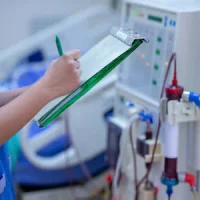In patients admitted to the ICU following surgery, trauma or septic shock, fluid boluses are often used to increase cardiac output and blood pressure. However, clinical evidence shows that excess fluid administration could be detrimental for patients and could lead to increased rates of acute kidney injury (AKI), prolonged days of mechanical ventilation and death. There are currently no established ultrasound measures of venous congestion that could reflect right-sided pressures and venous congestion to indicate that fluid administration is becoming harmful for the patient.
According to the Surviving Sepsis Campaign guidelines, assessments of volume responsiveness (VR) can guide fluid administration. However, there is very little evidence that VR-based strategies can improve outcomes in ICU patients. They do not assess elevations in right atrial pressure, which could play an important role in predicting AKI than markers of perfusion, CO or oxygen delivery, as already suggested by recent studies.
Doppler flow patterns of hepatic veins (HV), portal vein (PV), and intra-renal veins (RV) could accurately identify early stages of right-sided venous congestion in patients with cardiac dysfunction or those who have undergone heart surgery. However, to date, no data is available to determine the utility of HV, PV and RV in critically ill ICU patients.
A study was conducted to compare the morphology of HV, PV and RV waveform abnormalities in the prediction of major adverse kidney events at 30 days in critically ill patients. The primary outcome was a major adverse kidney event (MAKE-30), and the rate of MAKE-30 events was compared in patients with and without venous flow abnormalities in the hepatic, portal and intra-renal veins.
One hundred and fourteen patients were enrolled in the study, 59.7% of whom were males. All patients underwent an ultrasound evaluation of HV, PV and RV. Major adverse events at 30 days were compared in patients with and without venous flow abnormalities in the hepatic, portal and intra-renal veins. If the S to D wave reversal was present, the HV was considered abnormal. If the portal pulsatility index (PPI) was greater than 30%, the PV was considered abnormal. Study researchers also examined PPI as a continuous variable to assess small changes in portal vein flow and whether these changes were clinically important.
A MAKE-30 event occurred in 37.4% of patients of the entire cohort. Mortality at 30 days was 17.5%. 27.6% of patients demonstrated S to D reversal on their hepatic Doppler images. PPI was 30% in 41.1% of the patients. 22.4% of patients demonstrated biphasic renal vein signals, and 2.4% demonstrated monophasic renal vein signals. In the entire cohort, 7.9% of the patients had inadequate hepatic vein Doppler studies, 16.7% had inadequate portal vein Doppler studies, and 25.4% had inadequate renal vein Doppler studies. In patients with S to D reversal, 58.6% experienced a MAKE-30 event compared to 27.6% of patients without S to D reversal. Similarly, 46.2% of the patients with increased PPI experienced a MAKE-30 event compared to 28.6% with those who did not have increased PPI.
These findings suggest that obtaining hepatic, portal and renal venous Doppler assessments in critically ill patients is feasible and could help predict important clinical outcomes in critically ill patients.
Source: Critical Care
Image Credit: iStock










